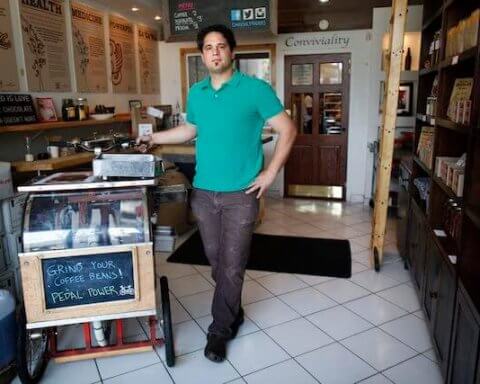Purpose matters. And we too often forget the purpose of finance. One of finance’s central goals is to help people allocate, save and raise money over time. Fundamentally, finance is a tool “to help people.” Finance scales ideas that create shared economic, social and environmental value – and, in turn, is used to help entrepreneurs and people alike. Finance serves people; people should not be slaves to financial markets. Finance is not about the sole accumulation of ever-increasing amounts of money, for the sake of accumulating money. Nor is finance about endlessly spending borrowed money one cannot repay. Financial markets, risk management and investments are not ends; they are merely tools, economic constructs and vehicles to help people.
Once we appreciate the underlying purpose of finance, we need to ask: “how can we improve financial tools, regulations, and models to better help people?” Impact investing, socially responsible investing, and social finance have emerged as responses to this very question. These approaches reconcile the original purpose of finance and the limitations of single-bottom-line thinking – all within existing economic, social, and environmental realities.
A crowd response to financing
Crowdfunding (CF) is geared towards pooling individual contributions together to finance ideas, projects, entrepreneurs, and organizations. CF is partially a reaction to the consolidated financial power of “Wall Street” and “Bay Street”. A commonly stated raison d’être for CF is to “democratize finance” – that is, to return more financial influence and decision-making to everyday people. CF is also a strategic game-changer with huge capital potential – especially given the well-documented dearth of financing for small organizations and social entrepreneurs.
Historically, the crowd has been a powerful source of answers, ideas, and financing. The crowd has greatly expanded Wikipedia, digitalized old books through reCAPTCHAs, and shared assets such as cars, vacation homes, and expertise. CF takes this trend even further, by allowing everyday people to more directly support initiatives that resonate with their values while investing in initiatives that deliver financial value.
Expanding and solidifying CF as a financing model
My focus is on debt crowdfunding (also known as P2P-lending), as opposed to equity, donation, or reward CF. According to the latest report by research firm Massolution, debt-CF volume grew 111% to US$1.2 billion between 2011 and 2012. For 2013, the CF sector is expected to double – again – in volume. The popularity has also spurred the creation of specialized crowdfunding platforms (CFPs) for diverse sectors such as community solar projects in the US (e.g. Solar Mosaic); businesses in the UK (e.g. Zopa); and even local musicians in Paris (e.g. MyMajor).
The following recommendations are focused on debt-CF but some also apply to equity-CF. In order expand and solidify debt-CF as a “mainstream” financing model, the CF sector needs to take steps to improve fraud prevention, crowd wisdom, financial liquidity and the balance between capital demand and supply.
Fraud – separating the good and the bad
The CF sector needs to address concerns over potential issuer fraud before it can become a widespread financing model. Thus far, CF has had an excellent record of facilitating good quality investments. According to Invest Crowdfund Canada, Australia has not experienced any successful cases of fraud in 7 years. In addition, a recent Ontario Securities’ Commission (OSC) paper reports a low 2% rate of fraud for existing non-equity CF. These low fraud rates must be maintained as the sector expands.
The CF process can be designed to minimize the probability – and severity – of issuer fraud. CFP websites can let investors comment and scrutinise issuers’ business plans in a transparent forum. Investor feedback creates reputational effects, influences the success of future campaigns by the same issuer, and increases the disincentive for fraud. In addition, CFPs can – and, in many cases, should – include an All-or-Nothing (AoN) feature. With AoN, issuers only receive CF proceeds if investment targets are met or exceeded. When coupled with community scrutiny and crowd wisdom, AoN reduces the probability of successful issuer fraud.
To minimize potential fraud, CFPs can implement sensible application processes, including fraud, background, and credit checks for potential issuers. A delicate trade-off exists between stringent application hurdles and access to finance for smaller issuers. As a potential solution, MyMicroInvest markets itself as a CFP that allows CF investors to invest on the same terms as a professional co-investor. This leverages the due diligence capabilities of professional investors and reduces potential fraud. In addition, annual investment maximums reduce potential investor losses due to issuer fraud.
CF investors are also concerned about investment losses due to bankruptcy or fraud at the CFP level. According to Bloomberg New Energy Finance, insurance and credit risk products already exist for investor protection. The business opportunity for insurance providers is to adapt such products to the growing CF sector. CFPs can further allay these concerns by holding CF proceeds in separate, designated accounts. As intermediaries, CFPs would be prudent to include such differentiating features to gain more credibility – and, in turn, attract investors and issuers.
Herd mentality – sparking crowd wisdom and protecting investors
According to a recent Crowdfund Insider article, CF can be subject to both crowd wisdom and herd mentality. A well known HBR article goes further and suggests “crowds are stupid” in equity-CF models. Indeed, the internet and social media can quickly feed good – as well as bad – investments. The “hype” of a project may prove appealing to the crowd but, ultimately, should not drive investment decisions.
Investor education is necessary as a first defence against herd mentality and systematically irrational risk-taking. The CF sector needs to promote greater financial literacy amongst both investors and issuers, frame CF investment risk in accessible terms – not legalese; and clearly communicate that not all projects will be financed, and that even “good” projects may not realise (exceptional) financial returns. CF projects have risk, and investors should not expect to get rich with CF projects.
On the regulatory side, investment maximums can be implemented for the CF sector. The US JOBS Act allows investors to invest a maximum amount depending on their annual income in any given 12-month period (e.g. up to US$2,000 or 5% of annual income for investors earning less than US$100,000 once SEC rules are finalized). The regulation is intended to limit an investor’s exposure beyond his/her means to withstand financial loss. Such regulation effectively amounts to financial paternalism – but may nonetheless be warranted as best practices are learned.
Investment maximums can be designed as a hard cap on the maximum issuers are allowed to raise, and/or the maximum investors are allowed to contribute (per investment or per period). Option one may reduce access to sufficient capital and stymie entrepreneurship. From a regulator perspective, option two may require investors self-certify that they have not exceeded the maximum, and would inevitably lead to compliance headaches.
Finally, we must recognize that herd mentality is not unique to CF. Financial markets are ripe with examples of systematically irrational risk taking by unaccredited as well as more “sophisticated” investors. In response, the OSC is considering 2 day cooling-off periods that allow CF investors to reflect on investment decisions. Taken together, investor education, transparent comments, investment maximums, and cooling-off periods help reduce the potential for – and losses from – herd mentality in the CF sector.
Financial liquidity – designing for robust secondary markets and liquidity events
The CF sector needs to assuage concerns over financial liquidity if CF investing is to expand. Currently, investors in various debt-CFPs need to lock-into terms of up to 10 years. Without exit opportunities for investors to trade and liquidate investments, the CF market implicitly excludes investors and restricts the total amount of available capital.
CFPs have devised unique solutions to this challenge. For instance, the Abundance Generation CFP has created an online bulletin board as “an introduction service enabling sellers to connect with potential buyers of Debentures.” Investors negotiate terms on an ad-hoc basis and are allowed to transfer debentures once registered with Abundance.
Secondly, put bonds can potentially help alleviate the lack of financial liquidity. A “put” design gives investors the right – but not the obligation – to demand early repayment from the issuer. This feature protects investors in the event of rising interest rates or poor project cash flows. Nonetheless, it represents an additional risk for issuers. In response, CF issuers should set specific repayment dates to prevent a liquidity crisis.
Financial liquidity is critical in capital markets. Ultimately, insufficient financial liquidity represents a paradox for the CF sector. Bloomberg suggests “without a secondary market, there will be no liquidity events for investors and therefore a small pool of investors … which prevents a secondary market.” Without a long-term, robust secondary market that allows investors to easily and quickly liquidate investments, CF will likely remain on the periphery of finance.
Demand and supply – balancing project pipelines and investors
Reconciling the demand for, and supply of, capital is central in efficient markets. CFPs need to develop a consistent pipeline of quality projects that are investment-ready. At the same time, CFPs need to attract interested investors willing to finance projects. The paradox is clear: projects create demand for investors, but investors create demand for projects.
If CFPs approve and list too many (poor quality) projects, some will be left sitting idle with little interest; if CFPs approve too few projects, investors will be left anxiously waiting. In fact, after Solar Mosaic investors fully funded all projects (totalling $313,000) in less than 24 hours, CEO Dan Rosen said, “Until we reach certain thresholds of liquidity and volume in our marketplace, project announcements may appear somewhat sporadic and choppy.” In finance, perception is powerful – and both idle investors and idle projects fuel a negative signal.
A solution can be drawn from the UK’s P2P lending platforms as well as the microlending sector. Reducing minimum investment thresholds – to, say, $10 in the case of Sunfunder – has been shown to increase the aggregate number of interested investors. Lower thresholds can be coupled with prospectus exemptions to further increase participation. Such participation increases word-of-mouth marketing but also increases transaction costs. CFP design is therefore critical and needs to fit operating conditions.
Another solution comes from Abundance’s pledging system. Potential investors can “pledge” early financial and community support for projects – which, in turn, attracts more project and investor interest. Investors can write letters asking councillors to support projects, or email planning authorities in return for a CFP fee discount. Project developers can also use pledges to gauge investor and community interest earlier in the project development process. Ultimately, CFPs need to balance both project development and investor outreach to drive project pipelines, investor interest, liquidity, scale, and continued CF growth.
The crowd as both an investor and a change agent
The crowd is a powerful change agent. Napster serves as a sobering reminder of creative destruction and the power of the crowd. The pioneering peer-to-peer file sharing service disrupted the status quo in 1999 and revolutionised the foundations of the music sector. Entrenched music labels underestimated the power of the crowd – and these incumbents paid the price. The finance sector would be unwise to do the same.
Crowdfunding is growing rapidly and has the potential to become a powerful and disruptive financing model. As expected, this new model faces temporary speed bumps and regulatory hiccups. Increased CF scale and volume will alleviate many of these challenges over time. In addition, the recommendations proposed for fraud prevention, investor protection, financial liquidity, and demand-supply balance are necessary for further growth. These recommendations allow CF investors to more directly support initiatives that resonate with their values, while investing in initiatives that create shared value.
CF is a powerful model that is open to “Main Street”, “Bay Street”, and everyone in-between. CF more directly connects investors with entrepreneurs – and, ultimately, returns finance to its fundamental purpose: to help people.
Will crowfunding grow into a mainstream financing model in 15 years – or in 5 years? Only the crowd knows.







